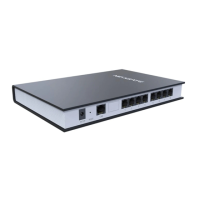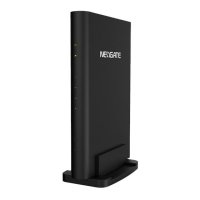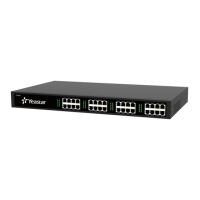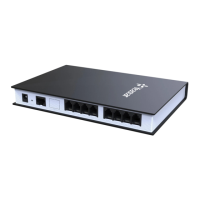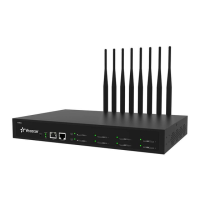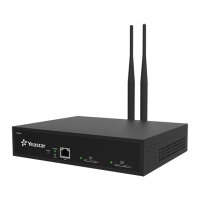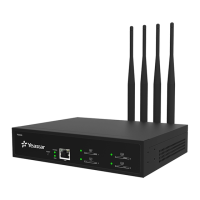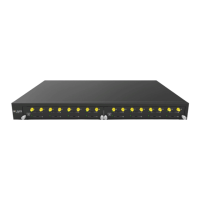Do you have a question about the Yeastar Technology TA810 and is the answer not in the manual?
| Fax over IP | T.38 |
|---|---|
| Protocols | SIP |
| Voice Codec | G.711 |
| Caller ID | DTMF |
| Power Supply | AC 100V-240V, 50/60Hz |
| Operating Temperature | 0°C |
| Storage Temperature | -20°C to 70°C |
| Humidity | 10% to 90% non-condensing |
| Weight | 1.2 kg |
Describes the intended audience for this user manual.
Provides essential safety precautions for working with electrical equipment.
Summarizes the key features and capabilities of the TA410/810 gateway.
Instructions on how to access the device's web-based graphical user interface.
Overview of the main sections within the web configuration panel.
Explains how the TA FXO gateway integrates with IPPBX and other systems.
Configures general parameters for FXO ports, including name, gain, and impedance.
Defines call duration limits, rounding, and alarm settings for FXO ports.
Configures hangup detection, answer detection, and caller ID settings for FXO ports.
Details the Round-Robin and Least Used strategies for port group selection.
Allows selection of FXO ports to be included in a specific port group.
Configuration for creating SIP accounts for device registration.
Settings for configuring SIP trunks to connect with a SIP provider.
Setup for peer-to-peer trunks authorized by IP address.
Grouping multiple SIP trunks for load balancing and routing.
Configures general SIP parameters like ports, timers, and security options.
Settings for Network Address Translation (NAT) to enable remote extensions.
Selection of audio codecs for voice compression and decompression.
Configures Quality of Service parameters to prioritize voice traffic.
Customizes SIP response codes for better call status understanding.
Advanced SIP parameters for fine-tuning call handling and security.
Configures IAX2 protocol settings like UDP port and registration timers.
Selection of codecs for IAX communication.
Defines routes for calls originating from SIP servers to FXO ports.
Configures routes for calls from PSTN trunks to SIP servers or other PSTN trunks.
Sets up rules to block specific incoming or outgoing calls.
Configures the callback feature for managing calls.
Configures global gateway parameters like call duration and encoding rate.
Allows uploading custom audio prompts for system announcements.
Configures ringback tones, dial tones, and busy tones for different regions.
Adjusts DTMF signal length, pause, and volume settings.
Configures the device's IP address, subnet mask, gateway, and DNS.
Manages access methods like SSH, FTP, HTTP, and HTTPS.
Configures Virtual Local Area Network (VLAN) settings for network segmentation.
Sets up Virtual Private Network (VPN) connections for secure remote access.
Configures Dynamic DNS for accessing the device using domain names.
Defines static routes for directing network traffic through specific gateways.
Enables and configures the firewall for network protection.
Monitors the status of services like SSH, FTP, HTTP, and HTTPS.
Manages security settings for SIP and HTTP ports.
Configures system alerts for IP attacks and web login attempts.
Configures Asterisk Manager Interface (AMI) for system monitoring.
Manages TLS/SSL certificates for secure communication.
Defines common and auto-defense rules for the firewall.
Sets up rules to automatically defend against high traffic rates.
Manages the IP blacklist to block unauthorized access.
Instructions for changing the system password for security.
Sets the system date, time, and time zone for accurate logging.
Configures automatic device provisioning via PNP, DHCP, or server URL.
Guides users through updating the device firmware via HTTP or TFTP.
Details how to back up and restore system configurations.
Provides options to reboot the system or reset it to factory defaults.
Displays the status of FXO ports and trunks, including up/down and idle/busy.
Shows the registration status of SIP/IAX and SP-SIP/IAX trunks.
Indicates the registration status of VoIP accounts with the SIP server.
Displays the IP address, subnet mask, and gateway status of the LAN port.
Shows hardware/firmware versions, SN, and system uptime.
Captures and allows searching of all call details for analysis.
Enables downloading and deleting system logs (hardware, normal, web, debug).
Integrates a packet capture tool for network troubleshooting.
Monitors and debugs FXO ports by capturing traffic.

